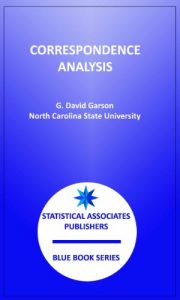A graduate-level introduction to correspondence analysis, which is a method of factoring categorical variables and displaying them in a property space which maps their association in two or more dimensions. Correspondence analysis is a special case of canonical correlation, where one set of entities (category levels rather than variables as in conventional canonical correlation) is related to another set.
Table of Contents
Overview5
Key Concepts and Terms6
Correspondence analysis6
Correspondence table6
Points6
Point distance6
Correspondence map6
The SPSS correspondence analysis interface8
The main correspondence analysis dialog8
The model dialog8
Dimensions in the solution9
Distance measure9
Standardization method10
Normalization method10
The statistics dialog14
The plots dialog14
SPSS correspondence analysis output15
Example15
The summary of dimensions table16
The correspondence table18
The perceptual map18
Row points and column points scatterplots20
Row profiles and column profiles tables20
Contribution tables21
Row and column confidence points tables23
Line Plots24
The permuted correspondence table25
Assumptions26
Data level and distribution26
Data do not need to be detrended26
Correlated variables which meet assumptions26
Model specification and significance testing27
Homogeneity of categories27
Correct labeling of dimensions27
Numerous categories27
Non-negative values28
Frequently Asked Questions28
What procedures are related to correspondence analysis?28
How does correspondence analysis of three variables work in multiple correspondence analysis (MCA)?29
Explain active vs. constrained categories.29
Explain supplementary categories.31
How is the distance between points computed in correspondence analysis?32
What is detrended correspondence analysis (DCA)?33
Bibliography35
Pagecount: 37
Table of Contents
Overview5
Key Concepts and Terms6
Correspondence analysis6
Correspondence table6
Points6
Point distance6
Correspondence map6
The SPSS correspondence analysis interface8
The main correspondence analysis dialog8
The model dialog8
Dimensions in the solution9
Distance measure9
Standardization method10
Normalization method10
The statistics dialog14
The plots dialog14
SPSS correspondence analysis output15
Example15
The summary of dimensions table16
The correspondence table18
The perceptual map18
Row points and column points scatterplots20
Row profiles and column profiles tables20
Contribution tables21
Row and column confidence points tables23
Line Plots24
The permuted correspondence table25
Assumptions26
Data level and distribution26
Data do not need to be detrended26
Correlated variables which meet assumptions26
Model specification and significance testing27
Homogeneity of categories27
Correct labeling of dimensions27
Numerous categories27
Non-negative values28
Frequently Asked Questions28
What procedures are related to correspondence analysis?28
How does correspondence analysis of three variables work in multiple correspondence analysis (MCA)?29
Explain active vs. constrained categories.29
Explain supplementary categories.31
How is the distance between points computed in correspondence analysis?32
What is detrended correspondence analysis (DCA)?33
Bibliography35
Pagecount: 37






